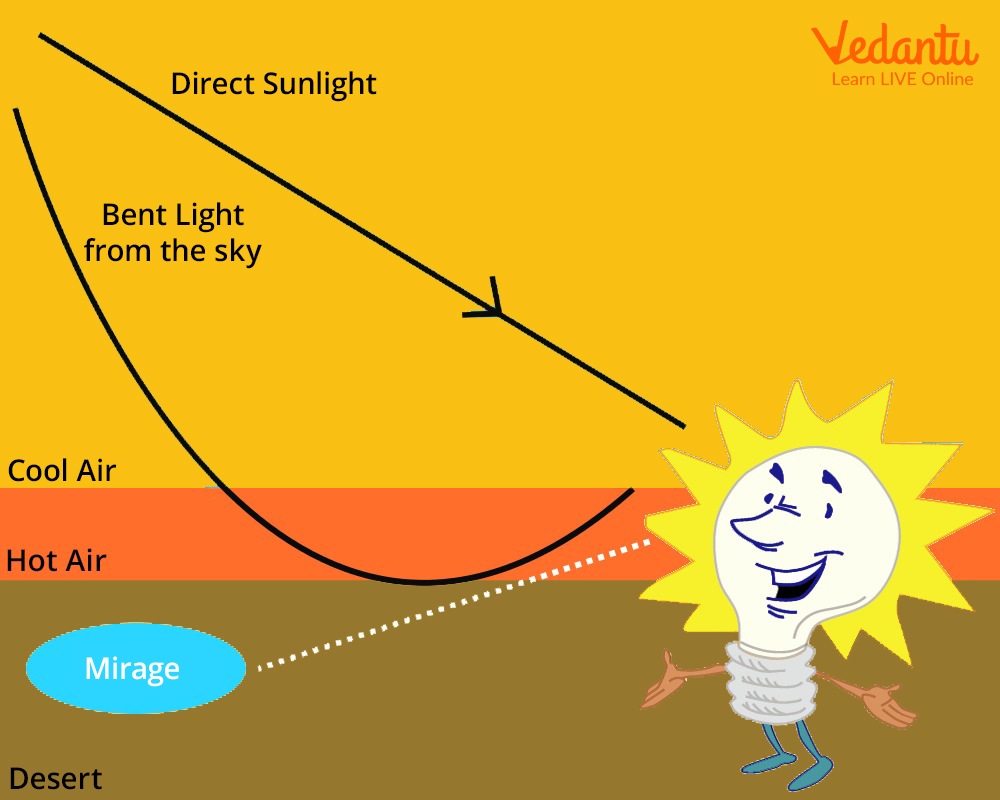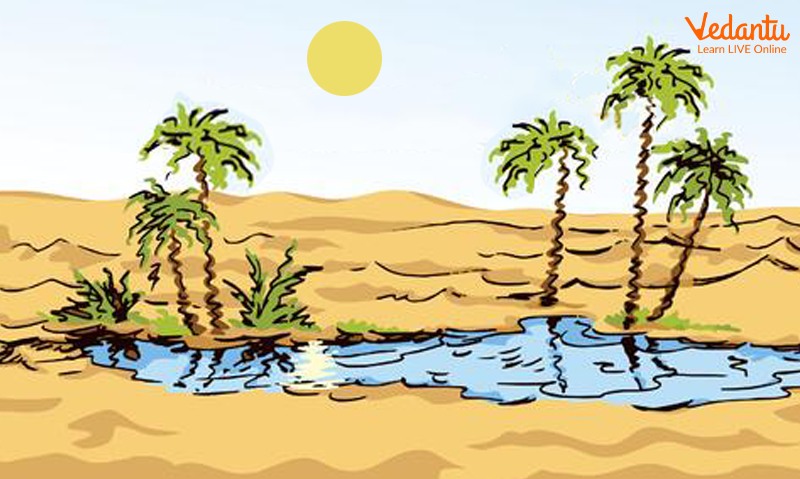




Introduction to Mirage
Have you read a desert story where the thirsty desert wanderer has been walking for hours and then he notices a large body of water on the horizon? He runs towards the water, which gets closer and closer until he jumps into the air, only to land in the sand with no water in sight. You might think the traveller was hallucinating, but a mirage is an optical illusion that occurs naturally.
Mirages are commonly depicted in cartoons as an oasis (a desert water body) under the shade of swaying palm trees, but the most realistic way to imagine them is as a pool of water or water mirage.

Oasis Mirage
What is a Mirage?
A mirage illusion is a naturally occurring optical phenomenon in which light rays bend due to refraction, resulting in a displaced image of distant objects or the sky. The word comes to English from the French mirer, which comes from the Latin mirari, which means "to look at, to wonder at."
How is the Mirage Effect Caused?
Mirages have absolutely nothing to do with water. It all comes down to how light travels through the air. Light waves from the sun normally travel straight through the atmosphere to your eye. However, light moves at different speeds through the hot and cold air.
Mirages appear when the ground is extremely hot and the air is exceptionally cool. The hot ground warms a layer of air just above the ground. Light is refracted as it passes through the cold air layer and into the hot air layer (bent).
A layer of very warm air near the ground bends the light from the sky nearly into a U-shaped bend. The brain interprets the path of the light as a straight line.
The image is not perceived by our brain as bent light from the sky. Instead, our brain interprets the light as coming from something on the ground.

Mirage in Desert
The image above shows what happens in order for a mirage to appear. The "bent light from the sky" is refracted as it travels from cooler to hotter air and then back to your eye. Your brain deceives by assuming that refracted light follows a straight path. As a result, the brain traces the light back to its source, which appears to be the ground. When all of this is considered, refracted light from the sky is interpreted as straight, allowing you to see an image of the sky on the ground.
As a result, many mirages appear as blue water. Observer believes that he has discovered an oasis (a desert water body) when, in fact, he is looking at a shimmering image of the blue sky. You imagine the image to be shining blue water because the brain does not recognize the sky as being on the ground. This can also be called a water mirage. You can observe water mirage on the roads also.
Where Can You See Mirages?
There's no need to travel to the desert to see a mirage; they can be found on highways, airport tarmacs, and even hot beach sand. Mirages can be seen anywhere the ground absorbs a lot of heat.
Mirage in Desert
You may have read in desert stories that people think they see trees or bodies of water far away, but as they get closer, these imaginary trees or bodies of water vanish. This occurs because of the mirage effect. And in this way, one can see the mirage in the desert.

Mirage in a Desert
Let's See, How do Layers of Air Above the Sea Create a Mirage?
When the seawater is very cold, the air above it becomes very cold as well. A warmer layer of air exists above this cold layer of air. Light reflected from a distant object, such as an island, will bend as it passes through these cold and warm layers. When this light enters your eyes, you believe you see the object floating in the sky. It might even appear to be upside down.
On Hot Days, Why Do You See Mirages?
When the air near the ground is extremely hot, sometimes we see a pool of water. The pool is actually a reflection of the sky caused by light bending.
Interesting Facts About Mirage
There is documented evidence that groups of people witnessed massive complex mirages in the form of entire cities in the heavens.
It appears frequently over Lake Baikal in Russia.
There are also occasional mirages in the Japanese coastal town of Watsu, which cause coastal houses to appear to soar above the bay's waters.
It can be obtained artificially.
A mirage is an image that appears to be real but is not. It is caused by different temperatures and thicknesses of air layers. Light can be bent due to differences in air layers. This bending, known as refraction, produces false images that people frequently believe to be real. As temperatures rise, gases such as air become thinner. As a result, light bends (or refracts) toward the colder layer of air. This gives the impression that the image is coming from a different direction than the original object.
FAQs on Mirage - An Illusion, the Beautiful Phenomenon of Nature
1. What is a mirage?
Mirage is the deceptive appearance of a distant object or objects caused by light ray bending (refraction) in different density layers of air. Light rays from the sun travel at different speeds through hot and cold air when they travel straight through the atmosphere. For a mirage to appear, the ground must be extremely hot and the surrounding air must be extremely cold. Warming occurs in the layer above the ground. When light passes through the cold air layer and into the hot air layer, it is refracted. Mirage is created in this way.
2. Do animals see mirages?
The fascinating truth is that animals perceive, and in many cases, they believe what they perceive to be true. So an incident worth mentioning is the effect of mirages on animals. During the summer, animals seek water. When they see it, they run in the direction of the mirage illusion, hoping to find water. In general, pre-formed opinion (perception) in the animal world is beneficial because it either makes the animal 'alert' in the first instance or 'verifies' in the second instance. Aside from that, the pre-formed opinion has no negative impact on animal life.





















